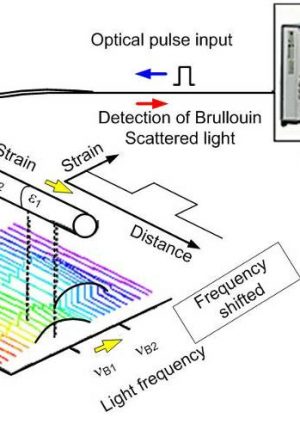How an Optical Fibre Diameter Analyser Enhances Manufacturing Accuracy
How an Optical Fibre Diameter Analyser Enhances Manufacturing Accuracy
Blog Article
Optimize Your Fibre Optic Performance: Recognizing Optical Fiber Size Analyser Technology
The efficiency of fibre optic systems is critically influenced by the accuracy of their size, a factor typically overlooked in the quest of ideal signal stability. Understanding the technology behind optical fibre size analysers discloses the elaborate balance in between measurement precision and manufacturing quality.
Value of Optical Fibre Diameter
The diameter of optical fiber plays a vital duty in determining the performance and efficiency of communication systems. Conversely, smaller sizes have a tendency to support less modes, which can improve signal clearness and lower crosstalk.

Moreover, understanding the size's ramifications can cause set you back savings by minimizing the requirement for signal boosting and repeaters in extensive networks (optical fibre diameter analyser). Finally, the importance of optical fiber size can not be overstated, as it directly impacts the general effectiveness and dependability of modern communication systems

How Diameter Impacts Signal Quality
Signal top quality in optical fibre systems pivots significantly on the size of the fibre. A smaller diameter can lead to higher depletion rates, resulting in signal loss as light travels via the fibre.
Conversely, bigger diameters typically enable improved light capture and minimized modal diffusion, improving signal quality. In multimode fibres, a larger core diameter can support multiple light modes, but it might additionally present intermodal diffusion, which can weaken signal quality. Consequently, picking the ideal fibre diameter is critical for accomplishing the desired performance in particular applications.
In addition, the interaction between the fiber diameter and the wavelength of the light made use of plays a vital duty in establishing the efficient transmission range and total signal honesty. Recognizing just how fibre diameter influences signal high quality is essential for network designers and engineers making every effort to enhance optical fibre systems for trustworthy, high-speed data transmission.
Overview of Size Analyser Innovation
In numerous optical fibre production procedures, precise measurement of fiber diameter is necessary for guaranteeing consistent performance and quality (optical fibre diameter analyser). Size analysers are advanced instruments designed to examine the physical measurements of optical fibres with high precision. They employ advanced optical and laser innovations to determine the size, ovality, and concentricity of the fibre, therefore supplying important information for top quality control
These analysers can operate in-line during Full Article the manufacturing process or as part of off-line testing procedures. In-line systems make it possible for real-time tracking, permitting suppliers to change specifications quickly, therefore maintaining optimal production problems. Off-line analysers, on the other hand, supply extensive assessments of batches, ensuring that any discrepancies from specified tolerances are identified and resolved.
Size analysers substantially add to the reduction of problems in optical fibres, improving overall item dependability. By regularly measuring essential criteria, these modern technologies facilitate conformity with industry criteria and specs. As the demand for high-performance optical fibres continues to rise, the duty of diameter analysers comes to be increasingly important in accomplishing the desired top quality and efficiency standards in fiber optic systems.
Key Attributes of Fibre Diameter Analysers
Although numerous versions of fibre size analysers exist, they generally share several essential features that improve their functionality and dependability. One of the most substantial functions is high-resolution dimension capabilities, which make certain precise size readings, critical for maintaining high quality control in fibre manufacturing. In addition, numerous analysers incorporate advanced optical sensors made to find minute variations in fibre size, therefore providing vital data for process optimization.
An additional vital attribute is real-time monitoring, enabling drivers to receive instant responses on fibre diameter throughout the manufacturing procedure (optical fibre diameter analyser). This capability helps with quick changes and reduces the likelihood of flaws. Lots of analysers likewise come furnished with straightforward interfaces, enabling drivers to conveniently browse through data and settings results
Additionally, durable information storage and analysis capabilities are necessary for tracking historic performance trends and guaranteeing conformity with industry criteria. These attributes jointly contribute to the effectiveness of fiber diameter analysers in optimizing fibre optic performance.
Finest Practices for Fibre Optimization

First, regular calibration of optical fibre size analysers is necessary. This ensures exact measurements and lessens potential inconsistencies that can affect performance. Next off, maintaining a tidy working environment is important; dust and contaminants can result in signify degradation.
Furthermore, it is essential to select fibres that go to this website fulfill specific application requirements. This includes evaluating aspects such as depletion, bandwidth, and environmental conditions. Correct her explanation installment techniques must also be abided by, consisting of staying clear of sharp bends and extreme stress, which can compromise fibre stability.
Moreover, using advanced monitoring systems can assist in real-time efficiency analyses, allowing punctual identification of problems. Routine screening and upkeep need to be carried out to make certain that fibers remain within ideal operational specifications.
Finally, training workers on the newest fibre optimization innovations and methodologies will boost their capacity to apply effective approaches. By adhering to these best practices, companies can substantially enhance the performance and life-span of their optical fibre systems, ensuring effective communication and data transfer.
Conclusion
In verdict, the combination of optical fibre size analyser modern technology is vital for maximizing fiber optic performance. By making certain exact dimensions of fibre dimensions, these analysers dramatically improve signal high quality and lower losses during information transmission.
Signal top quality in optical fibre systems hinges substantially on the size of the fibre.In several optical fibre production procedures, precise measurement of fiber size is vital for guaranteeing consistent efficiency and high quality. As the need for high-performance optical fibers continues to increase, the role of diameter analysers becomes progressively important in accomplishing the preferred top quality and performance standards in fiber optic systems.
These attributes collectively add to the efficiency of fiber size analysers in enhancing fiber optic efficiency.
In conclusion, the combination of optical fibre diameter analyser modern technology is essential for taking full advantage of fiber optic efficiency.
Report this page